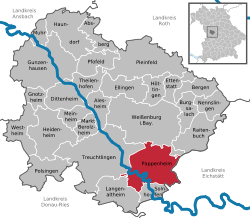Pappenheim
For other uses, see Pappenheim (disambiguation).
| Pappenheim | ||
|---|---|---|
|
Castle | ||
| ||
 Pappenheim | ||
Location of Pappenheim within Weißenburg-Gunzenhausen district  | ||
| Coordinates: 48°56′5″N 10°58′28″E / 48.93472°N 10.97444°ECoordinates: 48°56′5″N 10°58′28″E / 48.93472°N 10.97444°E | ||
| Country | Germany | |
| State | Bavaria | |
| Admin. region | Mittelfranken | |
| District | Weißenburg-Gunzenhausen | |
| Government | ||
| • Mayor | Peter Krauß (SPD) | |
| Area | ||
| • Total | 64.32 km2 (24.83 sq mi) | |
| Population (2015-12-31)[1] | ||
| • Total | 4,049 | |
| • Density | 63/km2 (160/sq mi) | |
| Time zone | CET/CEST (UTC+1/+2) | |
| Postal codes | 91788 | |
| Dialling codes | 09143 | |
| Vehicle registration | WUG | |
| Website | www.pappenheim.de | |
Pappenheim is a town in the Weißenburg-Gunzenhausen district, in Bavaria, Germany. It is situated on the river Altmühl, 11 km south of Weißenburg in Bayern.
Notable people
The architect and professor Eduard Mezger (1807–1894) was born in Pappenheim.
Else Pappenheim (1911-2009) and her father Martin Pappenheim (1881-1943), both were famous psychoanalysts.[2]
History
Main article: Pappenheim (state)
The Jewish cemetery from the 12th century.
Historically, Pappenheim was a statelet within Holy Roman Empire. It was mediatised to Bavaria in 1806.
Counts of Pappenheim settled at the territory, particularly Gottfried Heinrich Graf zu Pappenheim.
Sites
- Galluskirche
- Neues Schloss Pappenheim
- Altes Schloss
- German language Wikipedia entry on Else Pappenheim
References
- ↑ "Fortschreibung des Bevölkerungsstandes". Bayerisches Landesamt für Statistik und Datenverarbeitung (in German). June 2016.
- ↑ Martin Pappenheim gehörte zu den Mitbegründern der Vereinigung für psychische Hygiene Palästinas und führte Konsultationen in Ägypten und Syrien durch.
This article is issued from Wikipedia - version of the 5/12/2016. The text is available under the Creative Commons Attribution/Share Alike but additional terms may apply for the media files.
